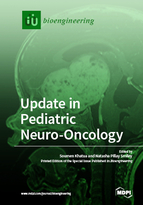Update in Pediatric Neuro-Oncology
A special issue of Bioengineering (ISSN 2306-5354).
Deadline for manuscript submissions: closed (15 August 2018) | Viewed by 64284
Special Issue Editors
Special Issue Information
Dear Colleagues,
This Special Issue welcomes papers that cover any aspects of pediatric neuro-oncology. Topics include, but are not limited to:
- Radiotherapy advances in pediatric brain tumors;
- Neurofibromatosis 1 and brain tumors in children;
- Molecular biology of pediatric gliomas and therapeutic insights;
- Embryonal tumors of the central nervous system in children- era of targeted therapeutics;
- Preclinical models in pediatric brain tumors—clinical relevance;
- Molecular neuroimaging of brain tumors;
- Palliative Care for Children with central nervous system malignancies;
- Neurocognitive and psychosocial outcomes following pediatric brain tumors.
Dr. Soumen Khatua
Dr. Natasha Pillay Smiley
Guest Editor
Manuscript Submission Information
Manuscripts should be submitted online at www.mdpi.com by registering and logging in to this website. Once you are registered, click here to go to the submission form. Manuscripts can be submitted until the deadline. All submissions that pass pre-check are peer-reviewed. Accepted papers will be published continuously in the journal (as soon as accepted) and will be listed together on the special issue website. Research articles, review articles as well as short communications are invited. For planned papers, a title and short abstract (about 100 words) can be sent to the Editorial Office for announcement on this website.
Submitted manuscripts should not have been published previously, nor be under consideration for publication elsewhere (except conference proceedings papers). All manuscripts are thoroughly refereed through a single-blind peer-review process. A guide for authors and other relevant information for submission of manuscripts is available on the Instructions for Authors page. Bioengineering is an international peer-reviewed open access monthly journal published by MDPI.
Please visit the Instructions for Authors page before submitting a manuscript. The Article Processing Charge (APC) for publication in this open access journal is 2700 CHF (Swiss Francs). Submitted papers should be well formatted and use good English. Authors may use MDPI's English editing service prior to publication or during author revisions.







